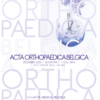Which design tolerates rotational mismatch better in unicompartmental knee arthroplasty: fixed or mobile bearing?
Unicompartmental knee arthroplasty; component rotation; tibiofemoral; rotational mismatch
Published online: Feb 17 2023
Abstract
Unicompartmental knee arthroplasty is an effective method for the treatment of medial compartment osteoarthritis. However, appropriate surgical tech- nique and optimum implant positioning are crucial for a satisfactory outcome. This study aimed to demonstrate the relation between the clinical scores and the alignment of the components in UKA. A total of 182 patients with medial compartment osteoarthritis and treated by UKA between January 2012 and January 2017 were enrolled in this study. Computed tomography (CT) was used to measure the rotation of components. Patients were divided into two groups according to the insert design. These groups were divided into three subgroups according to the angle of the tibia relative to the femur (TFRA) (A): TFRA 0° to 5° either internal or external rotation; (B): TFRA >5° internal rotation, and (C): TFRA >5° external rotation. There was no significant difference between the groups in terms of age, body mass index (BMI) and follow-up period. KSS scores increased as the tibial component rotation (TCR) external rotation increased, but there was no correlation for WOMAC score. (P: 0,039 r: 0,207; P:0,347 r:0,095, respectively) Post-operative KSS and WOMAC scores decreased as TFRA external rotation was increased. (p: 0,001; p:0,001, respectively) No correlation has been observed between femoral component rotation (FCR) internal rotation and post-operative KSS and WOMAC scores. (p: 0,261; p: 0,502, respectively) Any mismatch between the components is better tolerated by mobile-bearing designs compared to fixed-bearing designs. Orthopedic surgeons should take care of rotational mismatch of components, not only the axial alignment of the components.
